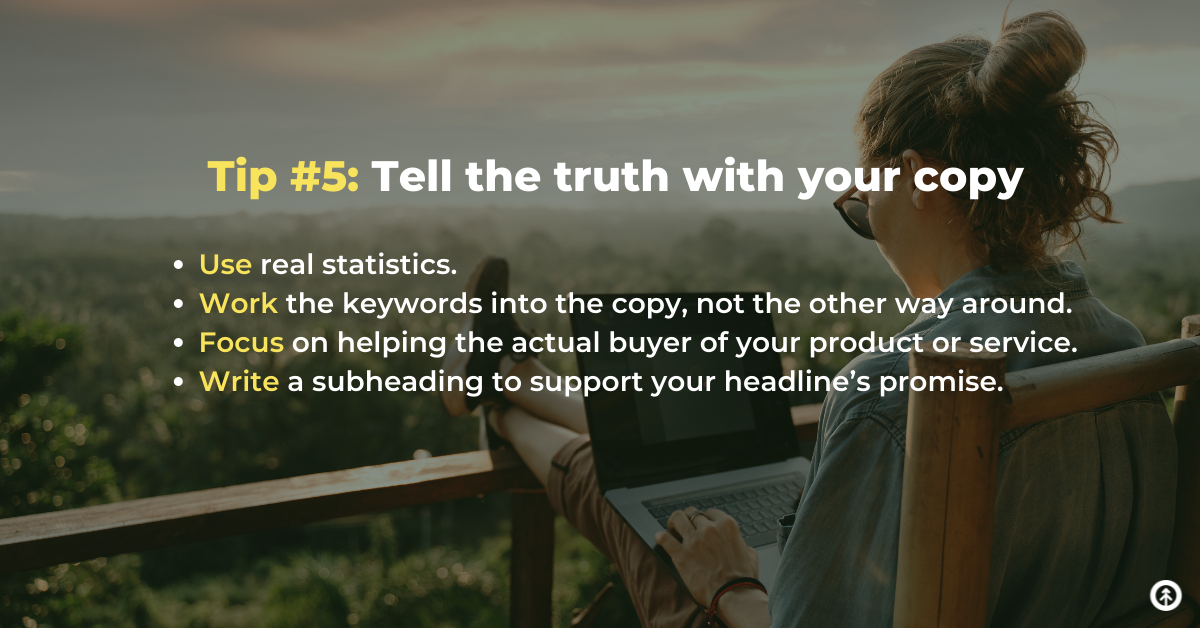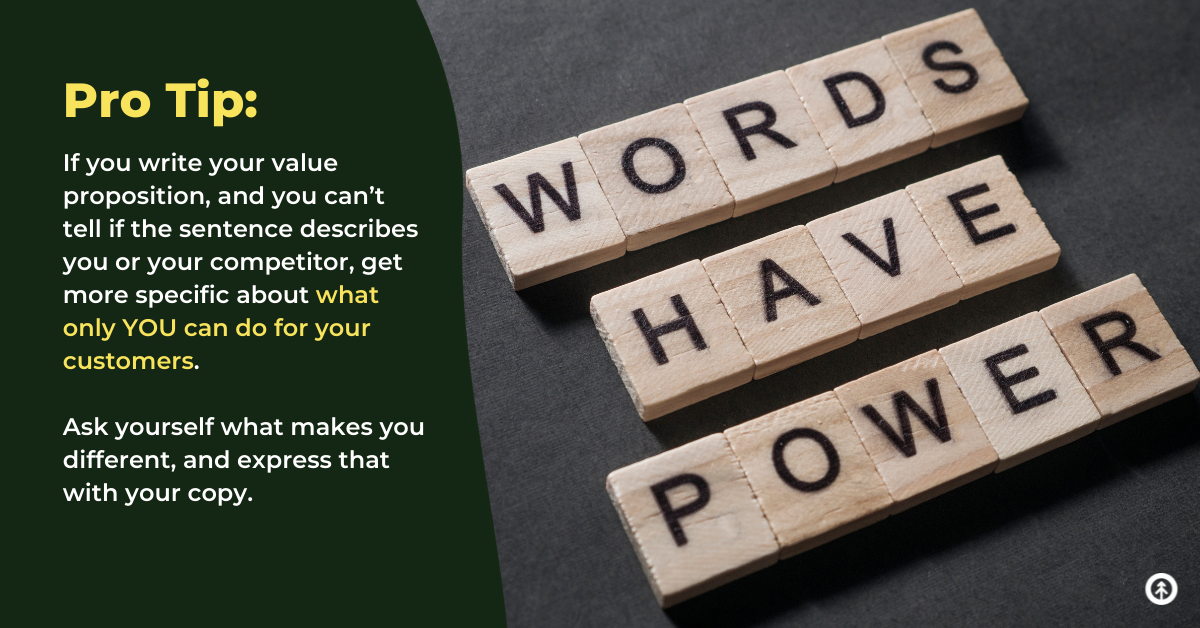8 Great Copywriting Tips from Growth
On this page
A copywriter’s job is to find the right word for the right customer at the right time and put it in the exact right place to drive sales.
The job is a big one. You also write video scripts (which are in a higher demand than ever), freewrite blog articles in your sleep, edit sales proposals, compose subject lines for email campaigns that truly get opened and read, create newsletters, and spin copy for the most effective websites out there.
Where there are words in marketing, there’s a copywriter still editing that copy in their head–even after hitting send.
So, how do you make it easier to help customers find what they need? Grab these 8 tips, and run with them.

- Write to your North Star customer
- Show; don’t tell
- Read
- Write
- Tell the truth
- Know the cost of each word
- Remember that it’s about the customer
- Get data
1. Write to your North Star customer
By “North Star,” we mean the customer of your dreams–the one you walk toward when you’re lost in the dark. Write to THAT person/company in your copy. If you write to (and for) someone specific, you’ll grab that person’s attention more than if you just write for everyone.
A North Star customer or client is a specific person, sure (you should have a buyer persona that outlines who they are), but they’re also a LOT of people at the same time.
Understand who they are and persuade them (and everyone like them) that what you offer is what they just can’t live without another second.
2. Show; don’t tell
Your job as a copywriter is to get people to act–to think, to feel, to understand, to learn, to buy. How can you expect your readers to act if your verbs are passive and your nouns are abstract?
Humans are visual creatures which is why video has us completely rapt at this point in digital history. So, writing copy that presents an image (versus an abstract idea) will always make people think, feel, understand, learn, SEE something–which will always get more action and engagement than copy that simply tells.
Pro Tip: Using more adjectives and adverbs doesn’t equate to a strong image. Strong, active, simple verbs + specific, tactile nouns evoke images in people's minds that inspire them to seek out a business. If you find yourself using too many adjectives and adverbs, let that be a tip-off that you need to dig deeper in your bag of nouns and verbs.
3. Read
Writers read; that’s just how it is. Why? Because we were hatched by books, story, song lyrics, comics, quest dialogue in games, whatever.
Those things inspire us, and that really never changes. Reading is one of the best ways to get inspired to write, and the more you write, the sharper that tool.
4. Write
Speaking of keeping the tools sharp: spend at least 10 minutes a day freewriting–literally writing whatever comes to your mind.
Complain about politics. Proclaim your admiration for your beloved. Describe what you had for breakfast. The topic doesn’t matter. This is about creating and maintaining your writing muscle.
Or start with a prompt. There are lists of topics for freewriting all over the internet, but you can also just look around the room and write about whatever your eyes land on.
After about a month or so, you’ll find yourself writing for 10 minutes on the word “dust.”
That’s when you’ll stretch in ways you could never have imagined.
5. Tell the truth

Flat copy stays flat when you exaggerate because people see right past it. They don’t act when they don’t believe the copy. Writing clickbait will grab attention, sure. But it won't capture the right audience for your product or service.
Trust that the positive, honest truth about the product or service you're selling is enough.
If you find yourself writing hyperbole over and over, it’s a sign that you either 1) don’t know enough about what you need to say or to whom you need to say it or 2) your heart’s not in it.
After you gather the information you need about your topic (and do all the dishes in the house twice to incubate good ideas + get your heart in the game), use these 4 tips to write honest, clear copy that drives traffic you need without resorting to hyperbole:
- Use real statistics.
- Work the keywords into the copy, not the other way around.
- Focus on helping the actual buyer of your product or service.
- Write a subheading to support your headline’s promise.
6. Know the cost of every word
Imagine that every word you write costs you $10K.
What if you had to shell out that money every time a word landed on the page?
Now that you’ve caught your breath, look at the copy you’re working on right now and think about which words to keep and which to chunk straight into a wood chipper.
That’s an easier decision, isn’t it?
It’s the ultimate editing hack–especially for websites.
Look hard at every verb.
Is there a better one you could use that could help you get rid of the adverb snuggled up next to it taking up valuable real estate? Use it.
The same goes for nouns.
As Mark Twain famously said: “Use the best word, not its second cousin.”
Because yes: hiring the strongest word–instead of five to help out a weaker one–is the best way to keep your copy tight and doing its job.
7. It’s not about you

The days of putting your company’s origin story on your website’s homepage are long gone, and, if that describes your website, it’s time for a do-over.
Now, the focus should be 100% on your customer. What does your business do for THEM?
That’s what they showed up on your website to find out.
So show them right there on page one–and every other page after that. Put your value proposition up front–use a verb in the very first sentence that describes exactly what your business does.
Here’s a formula to begin:
We + active verb + your customer + active verb + better.
Here's an example from Growth's value proposition (from which all our website copy springs): "We help businesses grow better."
Once you have that sentence down, play with it. Stretch for words that show exactly what you do for your customers and grab their attention at the same time.
Do that, and you’re golden.
Pro Tip: If you write your value proposition, and you can’t tell if the sentence describes you or your competitor, get more specific about what only YOU can do for your customers. Ask yourself what makes you different, and express that with your copy.
8. Copywriting is a science; get data to prove it
If you’re waiting months to figure out if your copy is doing its job, you’re standing still. Instead, you could be receiving insights about what’s working and what’s not in real time from a powerful CMS like HubSpot.
That way, you can quickly perform A/B testing on copy and get data on its performance immediately instead of waiting weeks.
Blog articles that show value to your customers do so with analytics + metrics like CTA clicks, low bounce rates, and the amount of time they spend reading them.
When you have these facts in hand, you can create more of what people need (which is the objective).
HubSpot’s dashboard is easy to customize and gives you up-to-the-minute insights into whether you should shift your verbal approach or go go go.
Speaking of HubSpot, Growth is a Platinum Solution Partner–which means we’re certified to help with everything from analytics to automation setups.
We’re onboarding specialists, and we help businesses get the most out of their HubSpot ROI. Curious? Talk to a human at Growth right this minute.
We do a lot of things to grow businesses here at Growth, but we also drive sales for our clients like crazy with our inbound marketing services.
Need copy? Oh. We’ve got copy. Come and get it, friends!
Explore More Insights: Related Blog Posts
-
 SEOAug 25, 2021
SEOAug 25, 2021 Growth Marketing Firm
Growth Marketing Firm6 Steps to Writing Website Copy that Converts
Your website is a 24/7 sales tool, so the copy on your site should work toward that goal, first and foremost....
-
 Inbound MarketingMar 14, 2022
Inbound MarketingMar 14, 2022 Growth Marketing Firm
Growth Marketing FirmHow to Create Productive CTAs
Inbound marketing focuses on creating valuable content that customers can really use in order to build...
-
 Marketing StrategyDec 20, 2021
Marketing StrategyDec 20, 2021 Growth Marketing Firm
Growth Marketing FirmWhat is Green Marketing + How to Build a Strategy
(Last updated October 4, 2022) Organizations that benefit from green marketing show that they’re committed to...
-
 Sales EnablementOct 3, 2021
Sales EnablementOct 3, 2021 Growth Marketing Firm
Growth Marketing FirmHow Efficient is Your Website? Our Grader Tool Knows. Ask It.
Cody Kloock · Website Grader A website grader is a tool that does exactly what its name suggests: it grades...
-
 Inbound MarketingApr 15, 2021
Inbound MarketingApr 15, 2021 Ashley Lilly
Ashley LillyThe Importance of Meta Descriptions for SEO
(last updated April 19, 2022) Let's get right down to it: Do meta descriptions matter? Yes! Why? The meta...
-
 SEOSep 21, 2022
SEOSep 21, 2022 Growth Marketing Firm
Growth Marketing FirmGoogle's Helpful Content Update: What Your Marketing Team Should Know
On September 9th, 2022, Google’s Helpful Content Update completed its rollout, so we’re all under its effect...
-
 Inbound MarketingSep 16, 2021
Inbound MarketingSep 16, 2021 Growth Marketing Firm
Growth Marketing FirmHow to Define & Write a Business Value Proposition
(last updated April 6, 2022) A value proposition is one of the most important sentences you'll ever write for...
-
 Website DesignSep 7, 2022
Website DesignSep 7, 2022 Growth Marketing Firm
Growth Marketing FirmWhat is Growth-Driven Design?
Growth-Driven Design (GDD) Definition Growth-Driven Design is a HubSpot-driven methodology for the design +...
-
 HubSpotFeb 23, 2022
HubSpotFeb 23, 2022 Growth Marketing Firm
Growth Marketing FirmWebsite Performance Metrics: Page Views v. Page Visits
When your website is your 24/7 sales team (if it’s not, it should be) paying attention to the data it brings...

